Construction Project Procurement Methods: An In-Depth Analysis
VerifiedAdded on 2022/10/11
|15
|2722
|12
Report
AI Summary
This report provides a comprehensive analysis of three distinct construction procurement methods: Design and Build (DB), Public-Private Partnership (PPP), and Integrated Project Delivery (IPD). It begins by defining the importance of selecting a suitable procurement method for successful project planning and construction. The report offers detailed discussions of each method, including their advantages and disadvantages, and their implications for various stakeholders such as developers, designers, contractors, subcontractors, and end-users. The analysis covers the benefits and challenges associated with each procurement approach, considering the interactions between different parties involved in the construction process. A comparison of the methods is provided, followed by a recommendation on the most appropriate method for different project scenarios. The report concludes with a summary of the key findings and emphasizes the importance of ethical considerations when advising clients on procurement strategies.
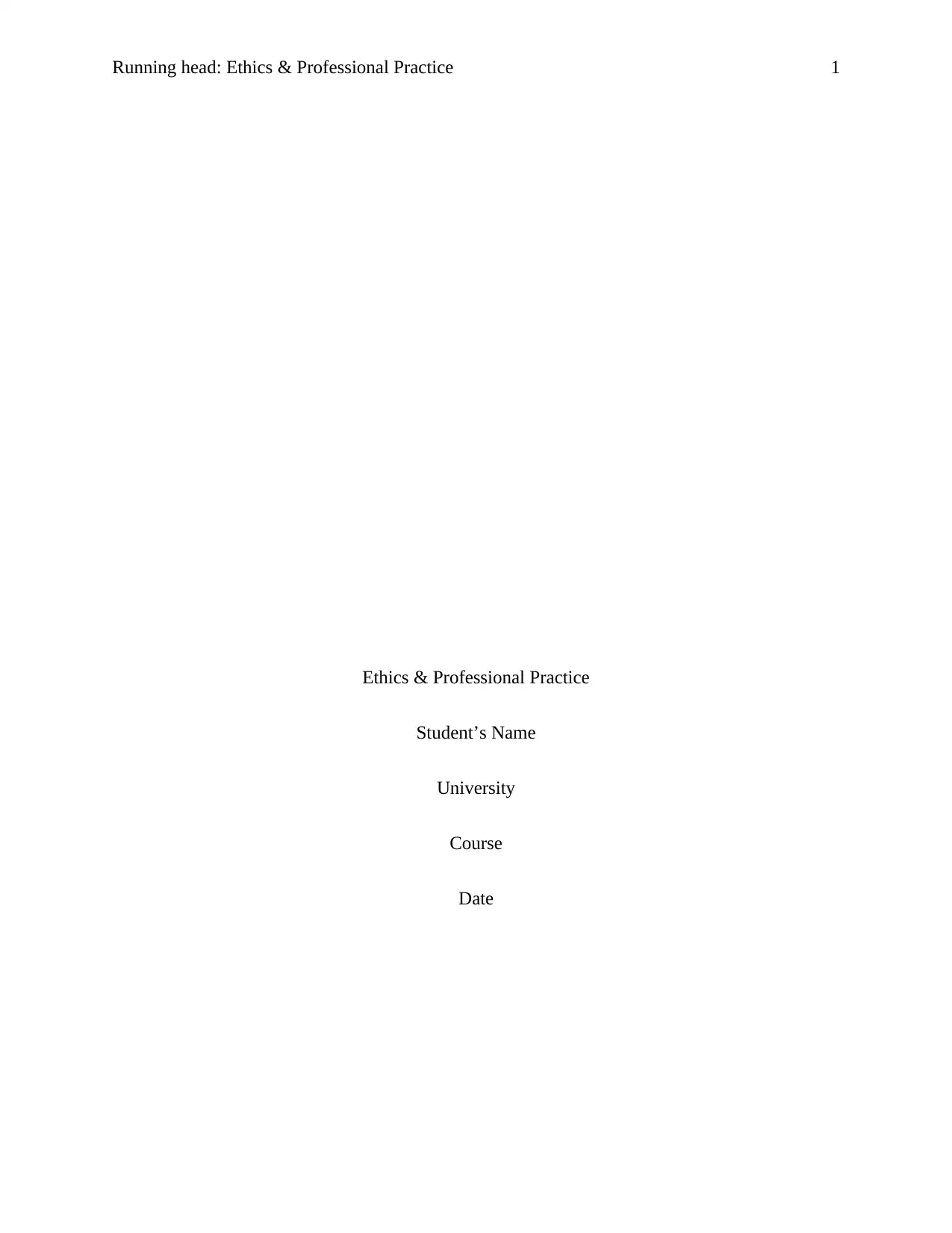
Running head: Ethics & Professional Practice 1
Ethics & Professional Practice
Student’s Name
University
Course
Date
Ethics & Professional Practice
Student’s Name
University
Course
Date
Paraphrase This Document
Need a fresh take? Get an instant paraphrase of this document with our AI Paraphraser
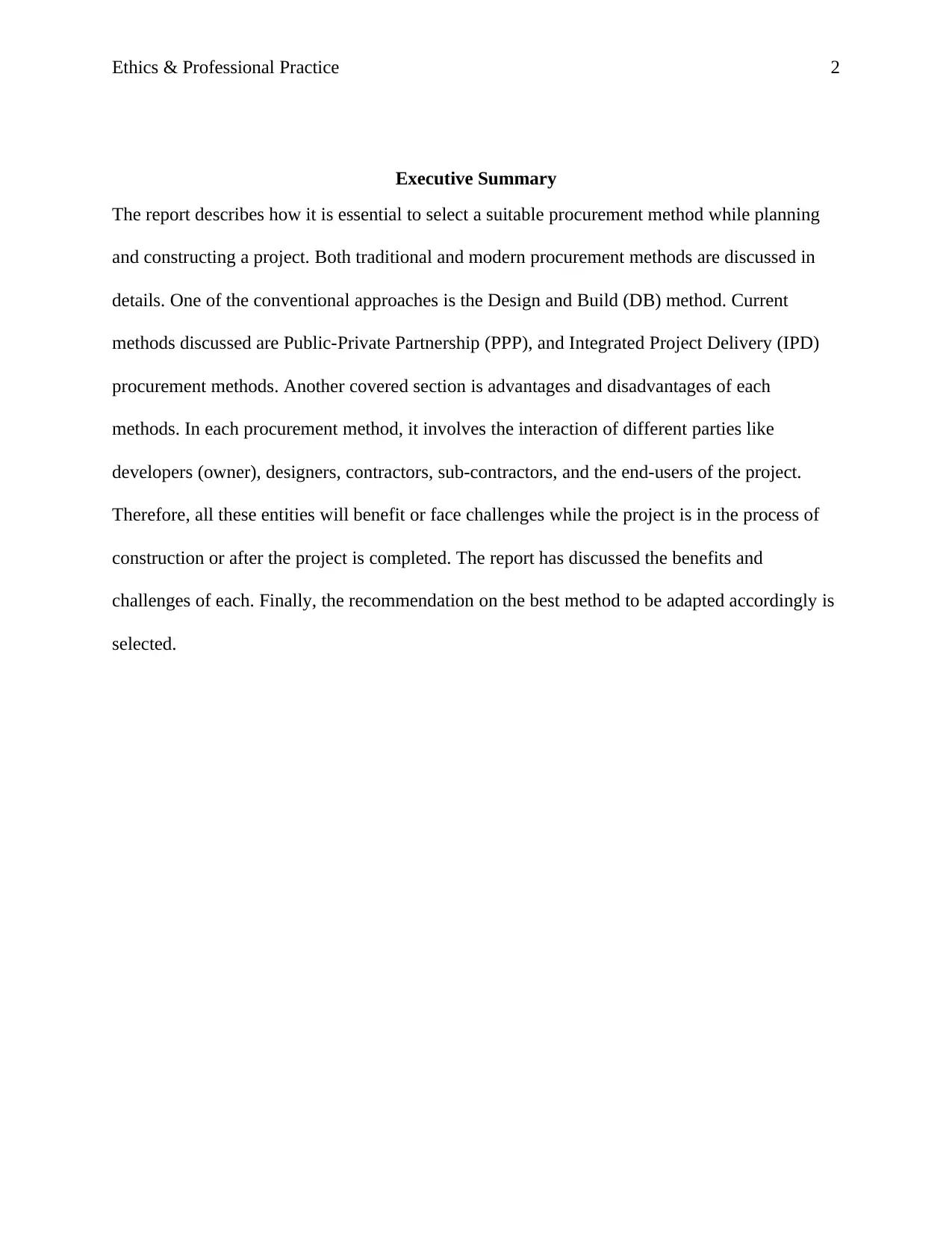
Ethics & Professional Practice 2
Executive Summary
The report describes how it is essential to select a suitable procurement method while planning
and constructing a project. Both traditional and modern procurement methods are discussed in
details. One of the conventional approaches is the Design and Build (DB) method. Current
methods discussed are Public-Private Partnership (PPP), and Integrated Project Delivery (IPD)
procurement methods. Another covered section is advantages and disadvantages of each
methods. In each procurement method, it involves the interaction of different parties like
developers (owner), designers, contractors, sub-contractors, and the end-users of the project.
Therefore, all these entities will benefit or face challenges while the project is in the process of
construction or after the project is completed. The report has discussed the benefits and
challenges of each. Finally, the recommendation on the best method to be adapted accordingly is
selected.
Executive Summary
The report describes how it is essential to select a suitable procurement method while planning
and constructing a project. Both traditional and modern procurement methods are discussed in
details. One of the conventional approaches is the Design and Build (DB) method. Current
methods discussed are Public-Private Partnership (PPP), and Integrated Project Delivery (IPD)
procurement methods. Another covered section is advantages and disadvantages of each
methods. In each procurement method, it involves the interaction of different parties like
developers (owner), designers, contractors, sub-contractors, and the end-users of the project.
Therefore, all these entities will benefit or face challenges while the project is in the process of
construction or after the project is completed. The report has discussed the benefits and
challenges of each. Finally, the recommendation on the best method to be adapted accordingly is
selected.
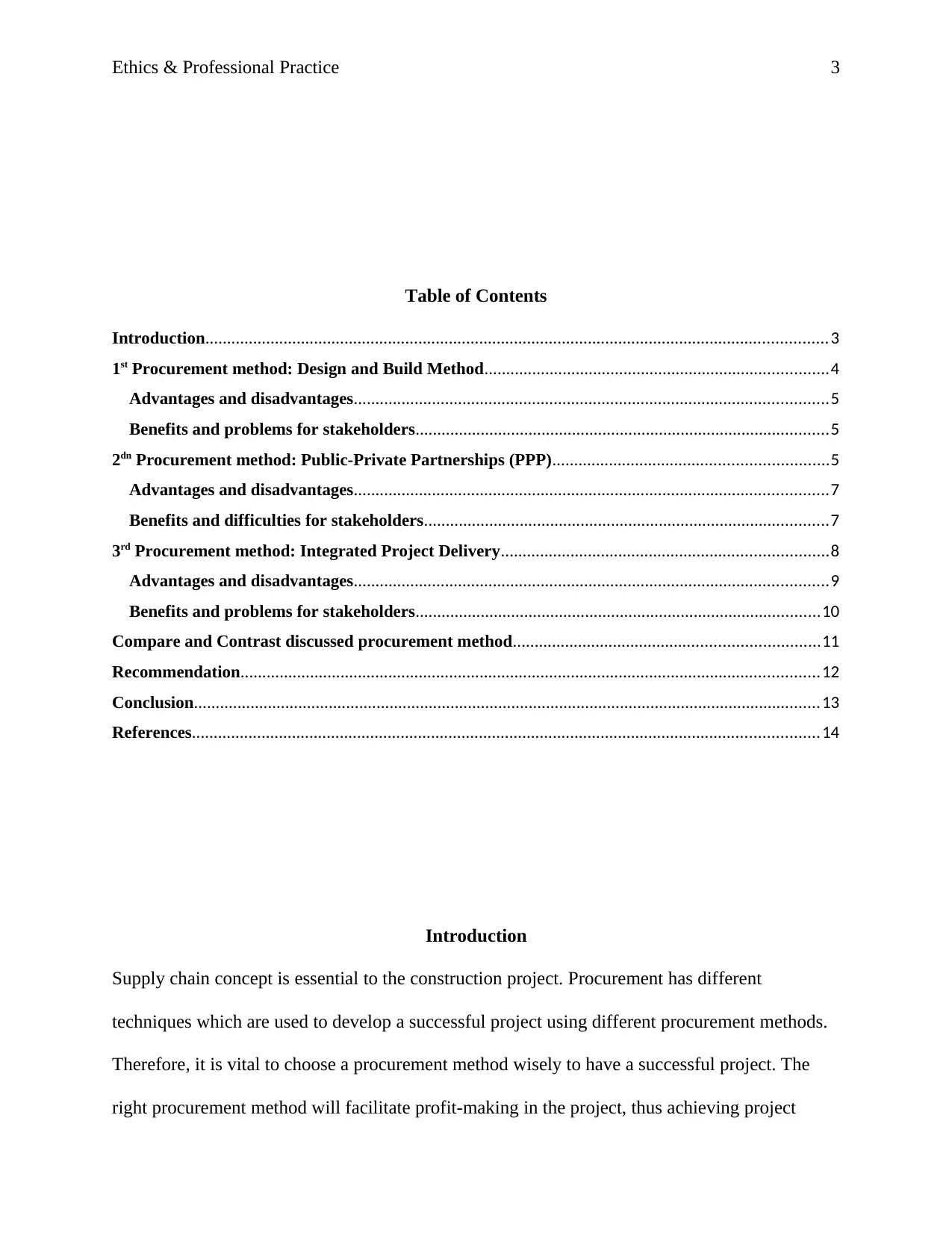
Ethics & Professional Practice 3
Table of Contents
Introduction...............................................................................................................................................3
1st Procurement method: Design and Build Method...............................................................................4
Advantages and disadvantages.............................................................................................................5
Benefits and problems for stakeholders...............................................................................................5
2dn Procurement method: Public-Private Partnerships (PPP)...............................................................5
Advantages and disadvantages.............................................................................................................7
Benefits and difficulties for stakeholders.............................................................................................7
3rd Procurement method: Integrated Project Delivery...........................................................................8
Advantages and disadvantages.............................................................................................................9
Benefits and problems for stakeholders.............................................................................................10
Compare and Contrast discussed procurement method......................................................................11
Recommendation.....................................................................................................................................12
Conclusion................................................................................................................................................13
References................................................................................................................................................14
Introduction
Supply chain concept is essential to the construction project. Procurement has different
techniques which are used to develop a successful project using different procurement methods.
Therefore, it is vital to choose a procurement method wisely to have a successful project. The
right procurement method will facilitate profit-making in the project, thus achieving project
Table of Contents
Introduction...............................................................................................................................................3
1st Procurement method: Design and Build Method...............................................................................4
Advantages and disadvantages.............................................................................................................5
Benefits and problems for stakeholders...............................................................................................5
2dn Procurement method: Public-Private Partnerships (PPP)...............................................................5
Advantages and disadvantages.............................................................................................................7
Benefits and difficulties for stakeholders.............................................................................................7
3rd Procurement method: Integrated Project Delivery...........................................................................8
Advantages and disadvantages.............................................................................................................9
Benefits and problems for stakeholders.............................................................................................10
Compare and Contrast discussed procurement method......................................................................11
Recommendation.....................................................................................................................................12
Conclusion................................................................................................................................................13
References................................................................................................................................................14
Introduction
Supply chain concept is essential to the construction project. Procurement has different
techniques which are used to develop a successful project using different procurement methods.
Therefore, it is vital to choose a procurement method wisely to have a successful project. The
right procurement method will facilitate profit-making in the project, thus achieving project
⊘ This is a preview!⊘
Do you want full access?
Subscribe today to unlock all pages.

Trusted by 1+ million students worldwide
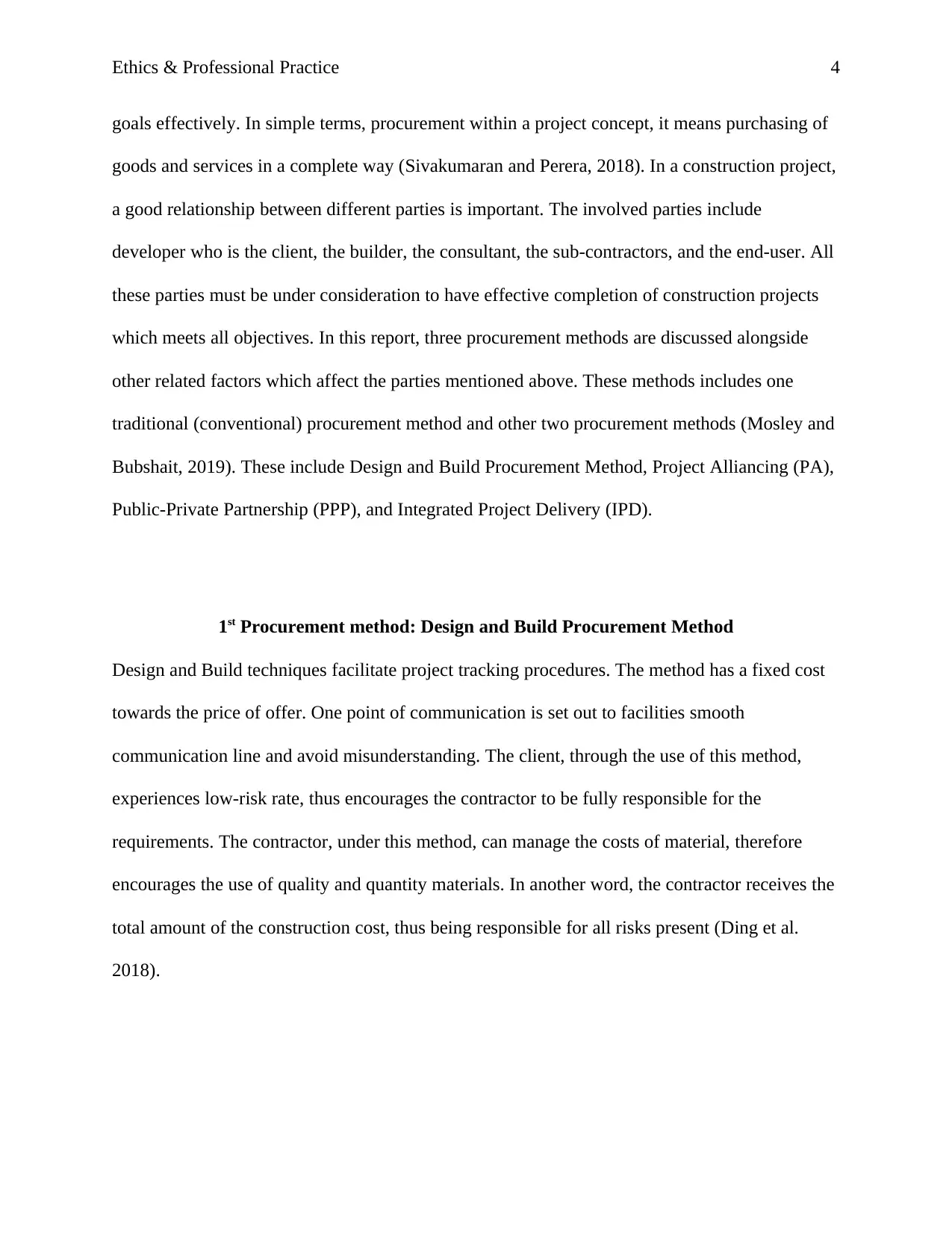
Ethics & Professional Practice 4
goals effectively. In simple terms, procurement within a project concept, it means purchasing of
goods and services in a complete way (Sivakumaran and Perera, 2018). In a construction project,
a good relationship between different parties is important. The involved parties include
developer who is the client, the builder, the consultant, the sub-contractors, and the end-user. All
these parties must be under consideration to have effective completion of construction projects
which meets all objectives. In this report, three procurement methods are discussed alongside
other related factors which affect the parties mentioned above. These methods includes one
traditional (conventional) procurement method and other two procurement methods (Mosley and
Bubshait, 2019). These include Design and Build Procurement Method, Project Alliancing (PA),
Public-Private Partnership (PPP), and Integrated Project Delivery (IPD).
1st Procurement method: Design and Build Procurement Method
Design and Build techniques facilitate project tracking procedures. The method has a fixed cost
towards the price of offer. One point of communication is set out to facilities smooth
communication line and avoid misunderstanding. The client, through the use of this method,
experiences low-risk rate, thus encourages the contractor to be fully responsible for the
requirements. The contractor, under this method, can manage the costs of material, therefore
encourages the use of quality and quantity materials. In another word, the contractor receives the
total amount of the construction cost, thus being responsible for all risks present (Ding et al.
2018).
goals effectively. In simple terms, procurement within a project concept, it means purchasing of
goods and services in a complete way (Sivakumaran and Perera, 2018). In a construction project,
a good relationship between different parties is important. The involved parties include
developer who is the client, the builder, the consultant, the sub-contractors, and the end-user. All
these parties must be under consideration to have effective completion of construction projects
which meets all objectives. In this report, three procurement methods are discussed alongside
other related factors which affect the parties mentioned above. These methods includes one
traditional (conventional) procurement method and other two procurement methods (Mosley and
Bubshait, 2019). These include Design and Build Procurement Method, Project Alliancing (PA),
Public-Private Partnership (PPP), and Integrated Project Delivery (IPD).
1st Procurement method: Design and Build Procurement Method
Design and Build techniques facilitate project tracking procedures. The method has a fixed cost
towards the price of offer. One point of communication is set out to facilities smooth
communication line and avoid misunderstanding. The client, through the use of this method,
experiences low-risk rate, thus encourages the contractor to be fully responsible for the
requirements. The contractor, under this method, can manage the costs of material, therefore
encourages the use of quality and quantity materials. In another word, the contractor receives the
total amount of the construction cost, thus being responsible for all risks present (Ding et al.
2018).
Paraphrase This Document
Need a fresh take? Get an instant paraphrase of this document with our AI Paraphraser
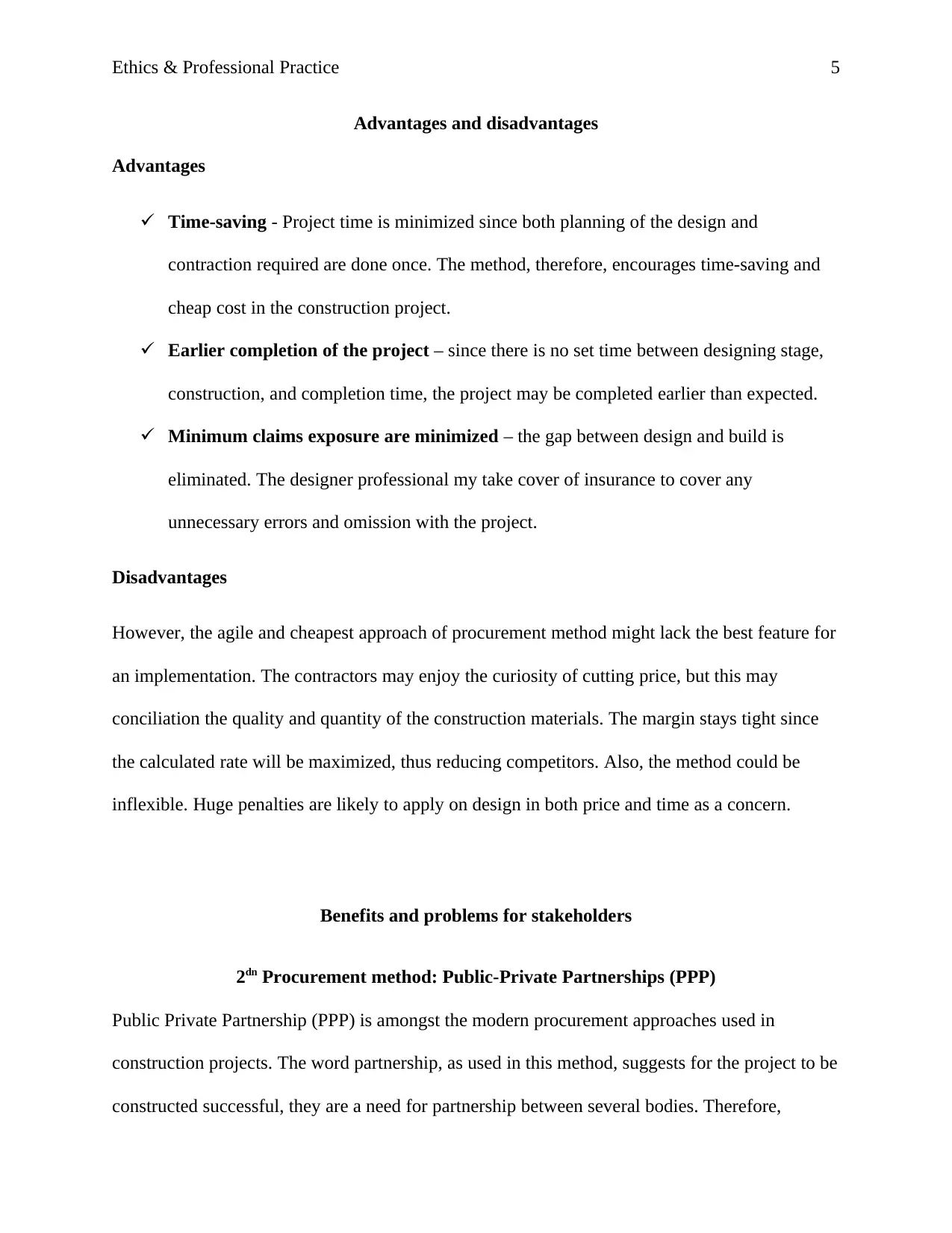
Ethics & Professional Practice 5
Advantages and disadvantages
Advantages
Time-saving - Project time is minimized since both planning of the design and
contraction required are done once. The method, therefore, encourages time-saving and
cheap cost in the construction project.
Earlier completion of the project – since there is no set time between designing stage,
construction, and completion time, the project may be completed earlier than expected.
Minimum claims exposure are minimized – the gap between design and build is
eliminated. The designer professional my take cover of insurance to cover any
unnecessary errors and omission with the project.
Disadvantages
However, the agile and cheapest approach of procurement method might lack the best feature for
an implementation. The contractors may enjoy the curiosity of cutting price, but this may
conciliation the quality and quantity of the construction materials. The margin stays tight since
the calculated rate will be maximized, thus reducing competitors. Also, the method could be
inflexible. Huge penalties are likely to apply on design in both price and time as a concern.
Benefits and problems for stakeholders
2dn Procurement method: Public-Private Partnerships (PPP)
Public Private Partnership (PPP) is amongst the modern procurement approaches used in
construction projects. The word partnership, as used in this method, suggests for the project to be
constructed successful, they are a need for partnership between several bodies. Therefore,
Advantages and disadvantages
Advantages
Time-saving - Project time is minimized since both planning of the design and
contraction required are done once. The method, therefore, encourages time-saving and
cheap cost in the construction project.
Earlier completion of the project – since there is no set time between designing stage,
construction, and completion time, the project may be completed earlier than expected.
Minimum claims exposure are minimized – the gap between design and build is
eliminated. The designer professional my take cover of insurance to cover any
unnecessary errors and omission with the project.
Disadvantages
However, the agile and cheapest approach of procurement method might lack the best feature for
an implementation. The contractors may enjoy the curiosity of cutting price, but this may
conciliation the quality and quantity of the construction materials. The margin stays tight since
the calculated rate will be maximized, thus reducing competitors. Also, the method could be
inflexible. Huge penalties are likely to apply on design in both price and time as a concern.
Benefits and problems for stakeholders
2dn Procurement method: Public-Private Partnerships (PPP)
Public Private Partnership (PPP) is amongst the modern procurement approaches used in
construction projects. The word partnership, as used in this method, suggests for the project to be
constructed successful, they are a need for partnership between several bodies. Therefore,
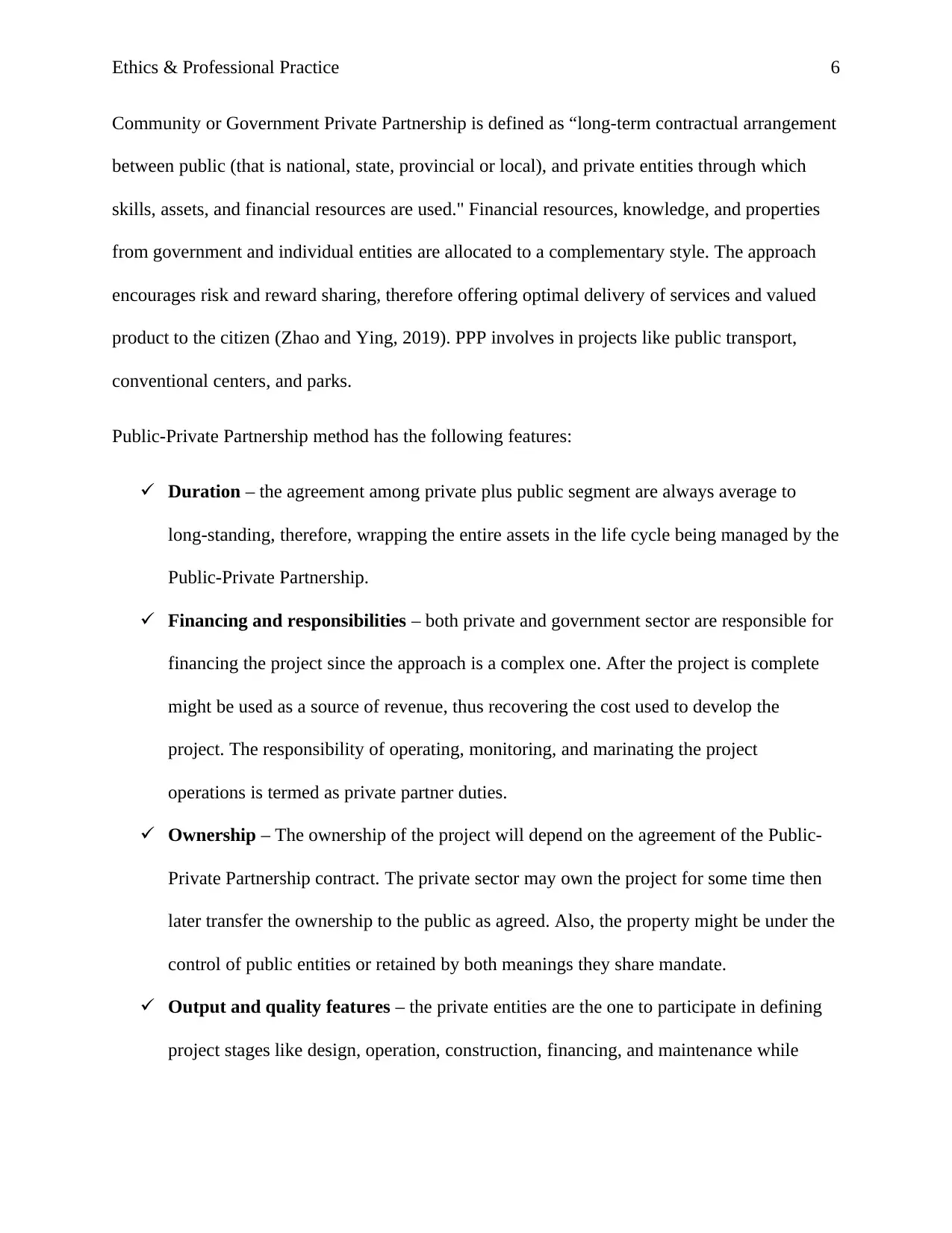
Ethics & Professional Practice 6
Community or Government Private Partnership is defined as “long-term contractual arrangement
between public (that is national, state, provincial or local), and private entities through which
skills, assets, and financial resources are used." Financial resources, knowledge, and properties
from government and individual entities are allocated to a complementary style. The approach
encourages risk and reward sharing, therefore offering optimal delivery of services and valued
product to the citizen (Zhao and Ying, 2019). PPP involves in projects like public transport,
conventional centers, and parks.
Public-Private Partnership method has the following features:
Duration – the agreement among private plus public segment are always average to
long-standing, therefore, wrapping the entire assets in the life cycle being managed by the
Public-Private Partnership.
Financing and responsibilities – both private and government sector are responsible for
financing the project since the approach is a complex one. After the project is complete
might be used as a source of revenue, thus recovering the cost used to develop the
project. The responsibility of operating, monitoring, and marinating the project
operations is termed as private partner duties.
Ownership – The ownership of the project will depend on the agreement of the Public-
Private Partnership contract. The private sector may own the project for some time then
later transfer the ownership to the public as agreed. Also, the property might be under the
control of public entities or retained by both meanings they share mandate.
Output and quality features – the private entities are the one to participate in defining
project stages like design, operation, construction, financing, and maintenance while
Community or Government Private Partnership is defined as “long-term contractual arrangement
between public (that is national, state, provincial or local), and private entities through which
skills, assets, and financial resources are used." Financial resources, knowledge, and properties
from government and individual entities are allocated to a complementary style. The approach
encourages risk and reward sharing, therefore offering optimal delivery of services and valued
product to the citizen (Zhao and Ying, 2019). PPP involves in projects like public transport,
conventional centers, and parks.
Public-Private Partnership method has the following features:
Duration – the agreement among private plus public segment are always average to
long-standing, therefore, wrapping the entire assets in the life cycle being managed by the
Public-Private Partnership.
Financing and responsibilities – both private and government sector are responsible for
financing the project since the approach is a complex one. After the project is complete
might be used as a source of revenue, thus recovering the cost used to develop the
project. The responsibility of operating, monitoring, and marinating the project
operations is termed as private partner duties.
Ownership – The ownership of the project will depend on the agreement of the Public-
Private Partnership contract. The private sector may own the project for some time then
later transfer the ownership to the public as agreed. Also, the property might be under the
control of public entities or retained by both meanings they share mandate.
Output and quality features – the private entities are the one to participate in defining
project stages like design, operation, construction, financing, and maintenance while
⊘ This is a preview!⊘
Do you want full access?
Subscribe today to unlock all pages.

Trusted by 1+ million students worldwide
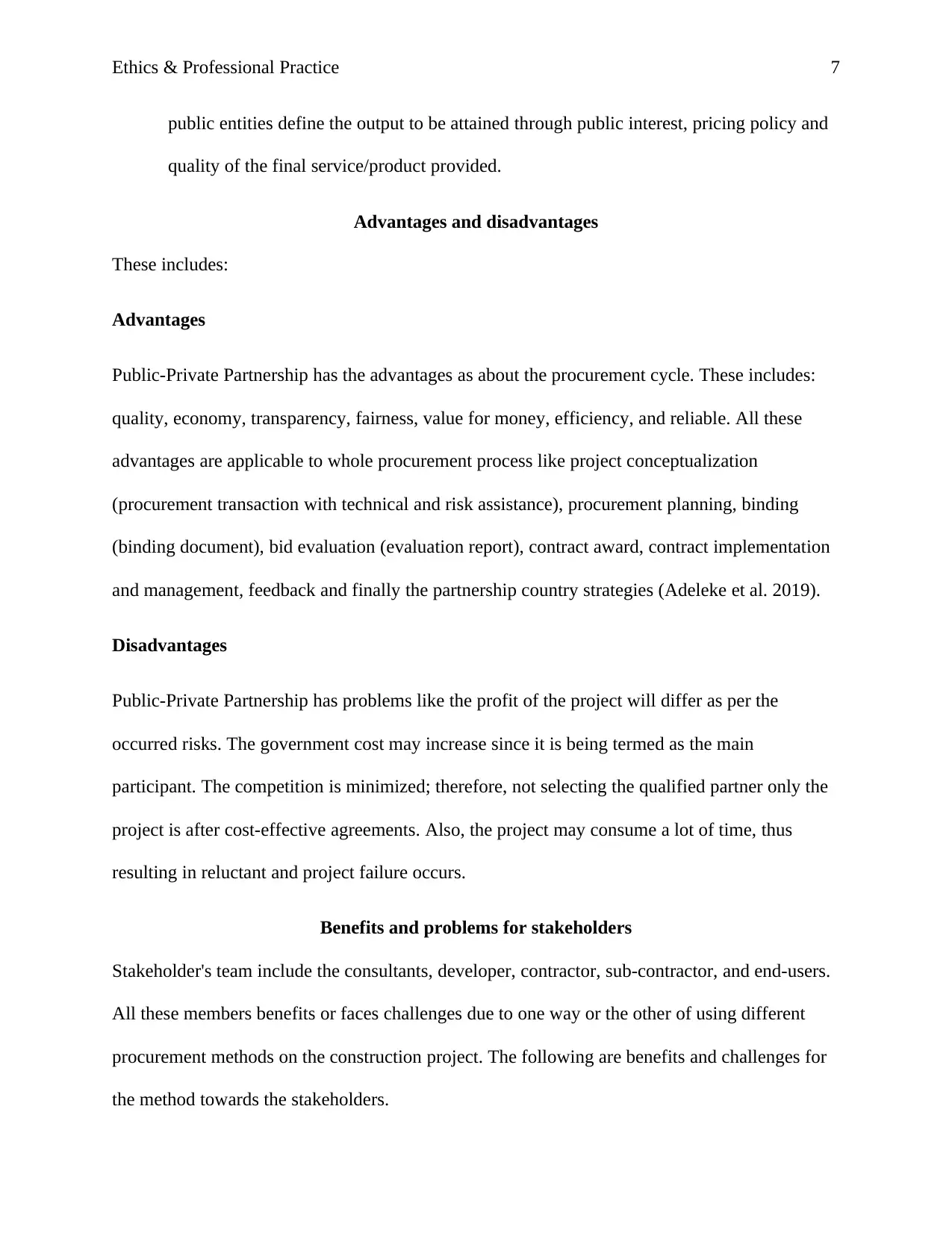
Ethics & Professional Practice 7
public entities define the output to be attained through public interest, pricing policy and
quality of the final service/product provided.
Advantages and disadvantages
These includes:
Advantages
Public-Private Partnership has the advantages as about the procurement cycle. These includes:
quality, economy, transparency, fairness, value for money, efficiency, and reliable. All these
advantages are applicable to whole procurement process like project conceptualization
(procurement transaction with technical and risk assistance), procurement planning, binding
(binding document), bid evaluation (evaluation report), contract award, contract implementation
and management, feedback and finally the partnership country strategies (Adeleke et al. 2019).
Disadvantages
Public-Private Partnership has problems like the profit of the project will differ as per the
occurred risks. The government cost may increase since it is being termed as the main
participant. The competition is minimized; therefore, not selecting the qualified partner only the
project is after cost-effective agreements. Also, the project may consume a lot of time, thus
resulting in reluctant and project failure occurs.
Benefits and problems for stakeholders
Stakeholder's team include the consultants, developer, contractor, sub-contractor, and end-users.
All these members benefits or faces challenges due to one way or the other of using different
procurement methods on the construction project. The following are benefits and challenges for
the method towards the stakeholders.
public entities define the output to be attained through public interest, pricing policy and
quality of the final service/product provided.
Advantages and disadvantages
These includes:
Advantages
Public-Private Partnership has the advantages as about the procurement cycle. These includes:
quality, economy, transparency, fairness, value for money, efficiency, and reliable. All these
advantages are applicable to whole procurement process like project conceptualization
(procurement transaction with technical and risk assistance), procurement planning, binding
(binding document), bid evaluation (evaluation report), contract award, contract implementation
and management, feedback and finally the partnership country strategies (Adeleke et al. 2019).
Disadvantages
Public-Private Partnership has problems like the profit of the project will differ as per the
occurred risks. The government cost may increase since it is being termed as the main
participant. The competition is minimized; therefore, not selecting the qualified partner only the
project is after cost-effective agreements. Also, the project may consume a lot of time, thus
resulting in reluctant and project failure occurs.
Benefits and problems for stakeholders
Stakeholder's team include the consultants, developer, contractor, sub-contractor, and end-users.
All these members benefits or faces challenges due to one way or the other of using different
procurement methods on the construction project. The following are benefits and challenges for
the method towards the stakeholders.
Paraphrase This Document
Need a fresh take? Get an instant paraphrase of this document with our AI Paraphraser
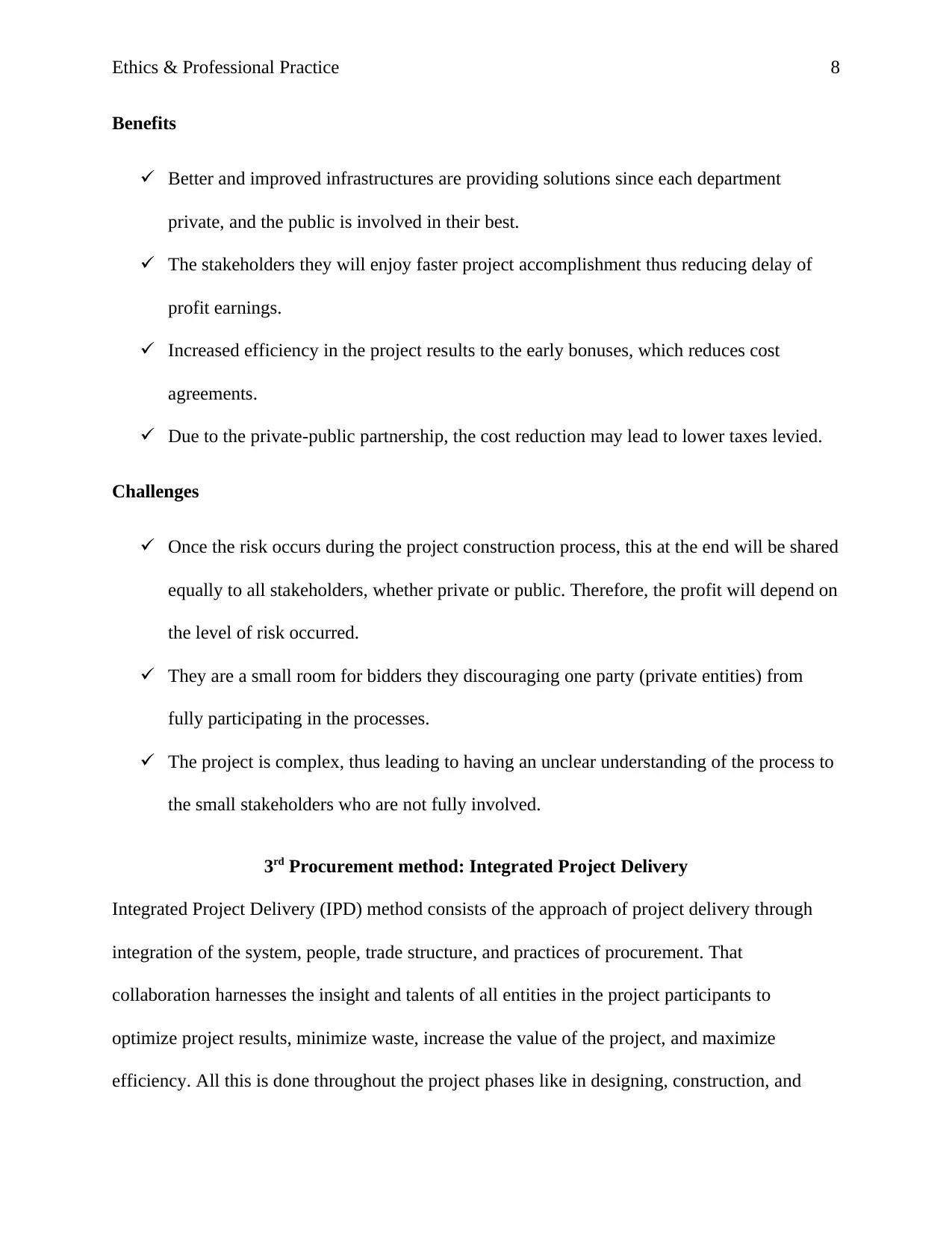
Ethics & Professional Practice 8
Benefits
Better and improved infrastructures are providing solutions since each department
private, and the public is involved in their best.
The stakeholders they will enjoy faster project accomplishment thus reducing delay of
profit earnings.
Increased efficiency in the project results to the early bonuses, which reduces cost
agreements.
Due to the private-public partnership, the cost reduction may lead to lower taxes levied.
Challenges
Once the risk occurs during the project construction process, this at the end will be shared
equally to all stakeholders, whether private or public. Therefore, the profit will depend on
the level of risk occurred.
They are a small room for bidders they discouraging one party (private entities) from
fully participating in the processes.
The project is complex, thus leading to having an unclear understanding of the process to
the small stakeholders who are not fully involved.
3rd Procurement method: Integrated Project Delivery
Integrated Project Delivery (IPD) method consists of the approach of project delivery through
integration of the system, people, trade structure, and practices of procurement. That
collaboration harnesses the insight and talents of all entities in the project participants to
optimize project results, minimize waste, increase the value of the project, and maximize
efficiency. All this is done throughout the project phases like in designing, construction, and
Benefits
Better and improved infrastructures are providing solutions since each department
private, and the public is involved in their best.
The stakeholders they will enjoy faster project accomplishment thus reducing delay of
profit earnings.
Increased efficiency in the project results to the early bonuses, which reduces cost
agreements.
Due to the private-public partnership, the cost reduction may lead to lower taxes levied.
Challenges
Once the risk occurs during the project construction process, this at the end will be shared
equally to all stakeholders, whether private or public. Therefore, the profit will depend on
the level of risk occurred.
They are a small room for bidders they discouraging one party (private entities) from
fully participating in the processes.
The project is complex, thus leading to having an unclear understanding of the process to
the small stakeholders who are not fully involved.
3rd Procurement method: Integrated Project Delivery
Integrated Project Delivery (IPD) method consists of the approach of project delivery through
integration of the system, people, trade structure, and practices of procurement. That
collaboration harnesses the insight and talents of all entities in the project participants to
optimize project results, minimize waste, increase the value of the project, and maximize
efficiency. All this is done throughout the project phases like in designing, construction, and
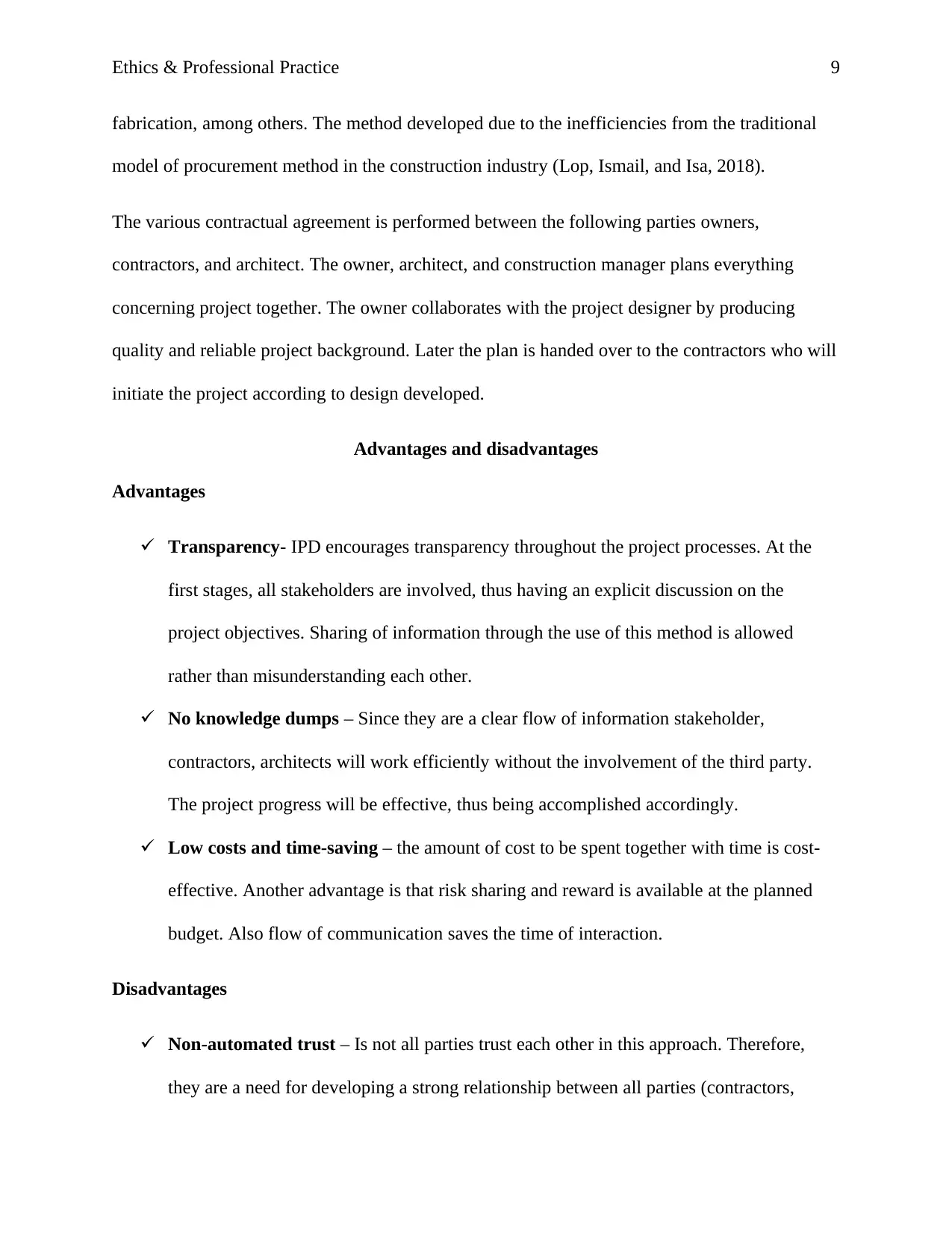
Ethics & Professional Practice 9
fabrication, among others. The method developed due to the inefficiencies from the traditional
model of procurement method in the construction industry (Lop, Ismail, and Isa, 2018).
The various contractual agreement is performed between the following parties owners,
contractors, and architect. The owner, architect, and construction manager plans everything
concerning project together. The owner collaborates with the project designer by producing
quality and reliable project background. Later the plan is handed over to the contractors who will
initiate the project according to design developed.
Advantages and disadvantages
Advantages
Transparency- IPD encourages transparency throughout the project processes. At the
first stages, all stakeholders are involved, thus having an explicit discussion on the
project objectives. Sharing of information through the use of this method is allowed
rather than misunderstanding each other.
No knowledge dumps – Since they are a clear flow of information stakeholder,
contractors, architects will work efficiently without the involvement of the third party.
The project progress will be effective, thus being accomplished accordingly.
Low costs and time-saving – the amount of cost to be spent together with time is cost-
effective. Another advantage is that risk sharing and reward is available at the planned
budget. Also flow of communication saves the time of interaction.
Disadvantages
Non-automated trust – Is not all parties trust each other in this approach. Therefore,
they are a need for developing a strong relationship between all parties (contractors,
fabrication, among others. The method developed due to the inefficiencies from the traditional
model of procurement method in the construction industry (Lop, Ismail, and Isa, 2018).
The various contractual agreement is performed between the following parties owners,
contractors, and architect. The owner, architect, and construction manager plans everything
concerning project together. The owner collaborates with the project designer by producing
quality and reliable project background. Later the plan is handed over to the contractors who will
initiate the project according to design developed.
Advantages and disadvantages
Advantages
Transparency- IPD encourages transparency throughout the project processes. At the
first stages, all stakeholders are involved, thus having an explicit discussion on the
project objectives. Sharing of information through the use of this method is allowed
rather than misunderstanding each other.
No knowledge dumps – Since they are a clear flow of information stakeholder,
contractors, architects will work efficiently without the involvement of the third party.
The project progress will be effective, thus being accomplished accordingly.
Low costs and time-saving – the amount of cost to be spent together with time is cost-
effective. Another advantage is that risk sharing and reward is available at the planned
budget. Also flow of communication saves the time of interaction.
Disadvantages
Non-automated trust – Is not all parties trust each other in this approach. Therefore,
they are a need for developing a strong relationship between all parties (contractors,
⊘ This is a preview!⊘
Do you want full access?
Subscribe today to unlock all pages.

Trusted by 1+ million students worldwide
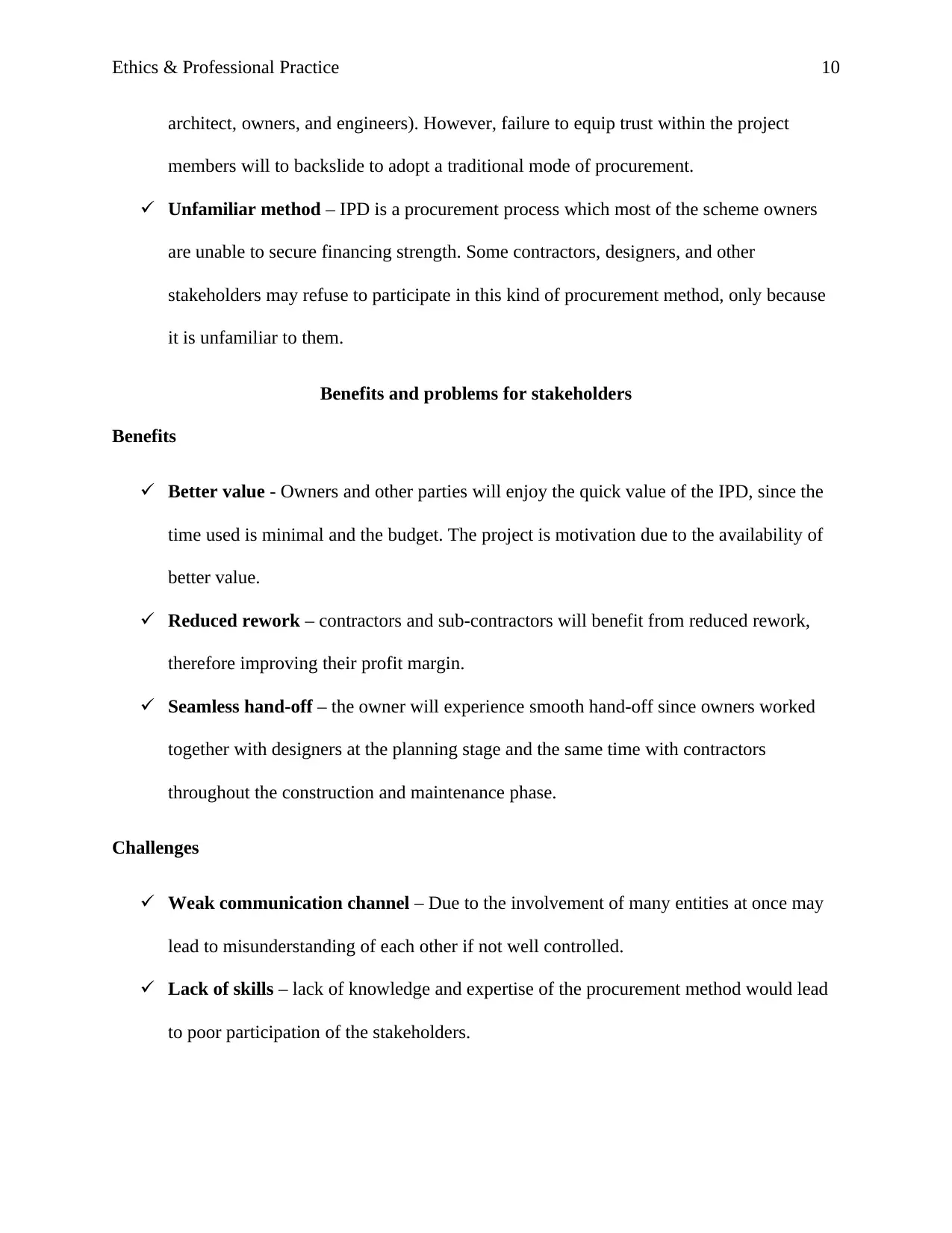
Ethics & Professional Practice 10
architect, owners, and engineers). However, failure to equip trust within the project
members will to backslide to adopt a traditional mode of procurement.
Unfamiliar method – IPD is a procurement process which most of the scheme owners
are unable to secure financing strength. Some contractors, designers, and other
stakeholders may refuse to participate in this kind of procurement method, only because
it is unfamiliar to them.
Benefits and problems for stakeholders
Benefits
Better value - Owners and other parties will enjoy the quick value of the IPD, since the
time used is minimal and the budget. The project is motivation due to the availability of
better value.
Reduced rework – contractors and sub-contractors will benefit from reduced rework,
therefore improving their profit margin.
Seamless hand-off – the owner will experience smooth hand-off since owners worked
together with designers at the planning stage and the same time with contractors
throughout the construction and maintenance phase.
Challenges
Weak communication channel – Due to the involvement of many entities at once may
lead to misunderstanding of each other if not well controlled.
Lack of skills – lack of knowledge and expertise of the procurement method would lead
to poor participation of the stakeholders.
architect, owners, and engineers). However, failure to equip trust within the project
members will to backslide to adopt a traditional mode of procurement.
Unfamiliar method – IPD is a procurement process which most of the scheme owners
are unable to secure financing strength. Some contractors, designers, and other
stakeholders may refuse to participate in this kind of procurement method, only because
it is unfamiliar to them.
Benefits and problems for stakeholders
Benefits
Better value - Owners and other parties will enjoy the quick value of the IPD, since the
time used is minimal and the budget. The project is motivation due to the availability of
better value.
Reduced rework – contractors and sub-contractors will benefit from reduced rework,
therefore improving their profit margin.
Seamless hand-off – the owner will experience smooth hand-off since owners worked
together with designers at the planning stage and the same time with contractors
throughout the construction and maintenance phase.
Challenges
Weak communication channel – Due to the involvement of many entities at once may
lead to misunderstanding of each other if not well controlled.
Lack of skills – lack of knowledge and expertise of the procurement method would lead
to poor participation of the stakeholders.
Paraphrase This Document
Need a fresh take? Get an instant paraphrase of this document with our AI Paraphraser
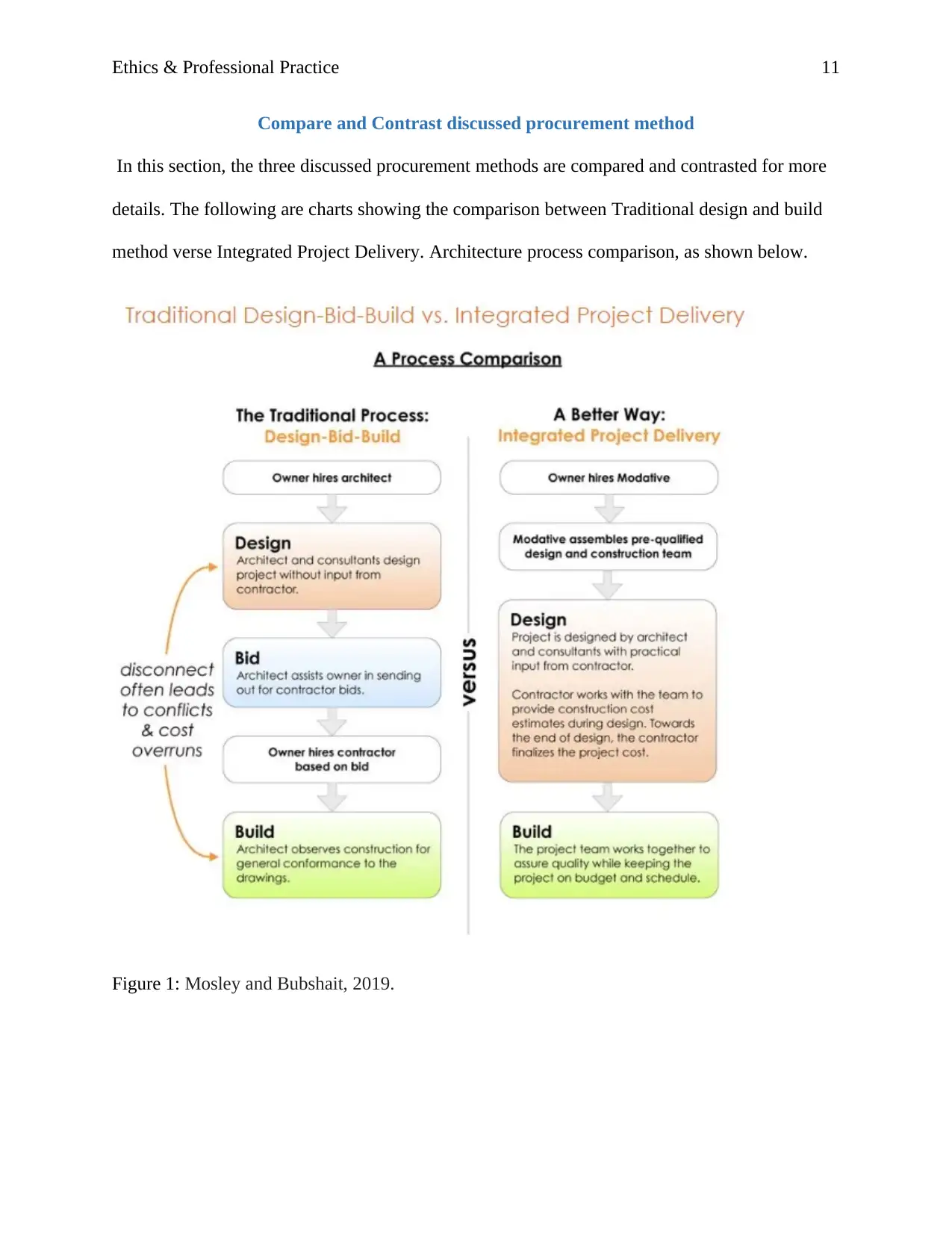
Ethics & Professional Practice 11
Compare and Contrast discussed procurement method
In this section, the three discussed procurement methods are compared and contrasted for more
details. The following are charts showing the comparison between Traditional design and build
method verse Integrated Project Delivery. Architecture process comparison, as shown below.
Figure 1: Mosley and Bubshait, 2019.
Compare and Contrast discussed procurement method
In this section, the three discussed procurement methods are compared and contrasted for more
details. The following are charts showing the comparison between Traditional design and build
method verse Integrated Project Delivery. Architecture process comparison, as shown below.
Figure 1: Mosley and Bubshait, 2019.
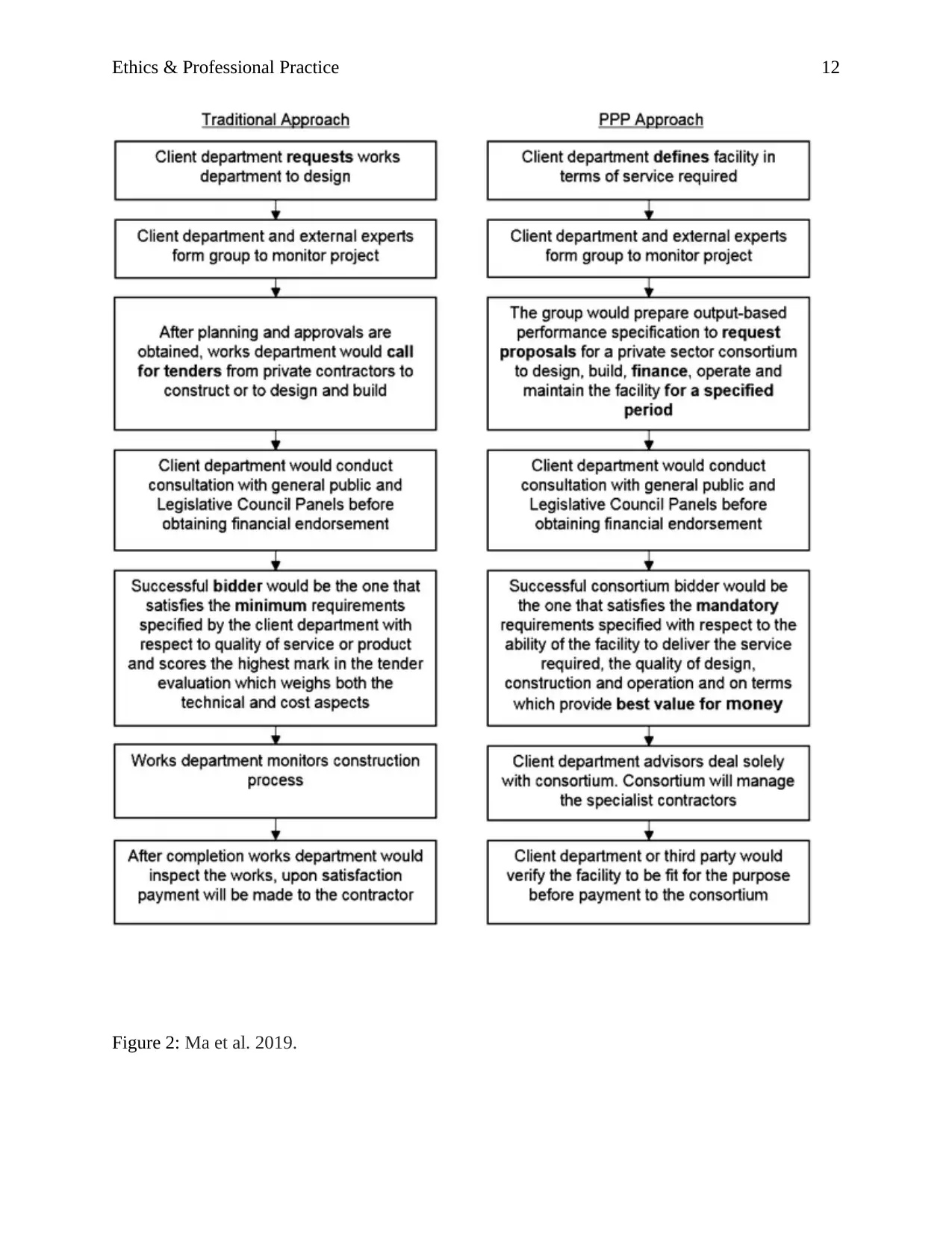
Ethics & Professional Practice 12
Figure 2: Ma et al. 2019.
Figure 2: Ma et al. 2019.
⊘ This is a preview!⊘
Do you want full access?
Subscribe today to unlock all pages.

Trusted by 1+ million students worldwide
1 out of 15
Related Documents
Your All-in-One AI-Powered Toolkit for Academic Success.
+13062052269
info@desklib.com
Available 24*7 on WhatsApp / Email
![[object Object]](/_next/static/media/star-bottom.7253800d.svg)
Unlock your academic potential
Copyright © 2020–2025 A2Z Services. All Rights Reserved. Developed and managed by ZUCOL.





